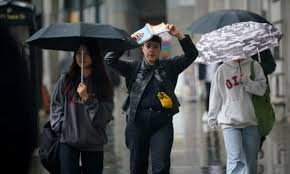‘I find them quite magical’: the UK’s obsession with weather apps

Harriet Sherwood
London: Several times a day, Francesca Simon, the author of the Horrid Henry children’s books, gets out her phone to check the weather – not just for where she is, but where friends and family live, where she has been on holiday, where she was brought up.
“I love weather apps. I find them quite magical,” she said. With about 10 locations logged, her friends make fun of her “weather porn” habit. “If I don’t like what I’m seeing on one app, I’ll check another.”
This week, Simon discovered she shared a weather app fixation with Queen Camilla when the pair discussed a miserable summer’s day at a charity event. “[Camilla] said everybody teases her … so we were laughing at our mutual obsession,” Simon said.
It is an obsession shared by millions. If you are going on holiday, planning a summer barbecue, worrying about your garden or suffering from hay fever, you are likely to check an app at least daily for the latest forecast.
The apps give much more localised and detailed information than traditional weather forecasts, including wind speeds and the percentage chance of rain, in graphic form.
It is a lucrative business. Most basic weather apps are free to use, but make money from advertising, paid upgrades and data monetisation. In 2022, Statista said global revenue in the weather market was projected to reach $1.58bn, with most income from advertising revenue.
According to a YouGov poll last year, apps were the primary source of weather information for Americans, used by 53% of people. One in five people said they checked apps multiple times a day. And the older they were, the more often they checked.
For people needing specific weather information, there may be a bespoke app available. For example, Windy tracks the speed and direction of wind, and the Met Office has introduced dedicated beach (partnered with the Royal National Lifeboat Institution) and mountain forecasts for the UK.
Most apps provide wind speeds and directions, sunrise and sunset times, UV forecasts, pollen counts and air pollution indicators. Some offer users extreme weather alerts.
The Met Office launched its weather app in 2010 and released a major update in 2016. By 2023 it had about 6.2 million users, mostly based in the UK. Usage spikes in times of severe weather, such as named storms and heatwaves.
The app is under “continual development” and has become more sophisticated since its launch, said Grahame Madge, a Met Office spokesperson.
It provides “granular detail for the next 24 hours”, but the further ahead users look, the more generalised the forecast. “We are analysed on accuracy, and come out as one of the top centres in the world,” said Madge. “We’re immensely proud of that.”
As a government agency, the Met Office provides data for other weather forecasters. But three years after the BBC launched its weather app in 2013, it switched to MeteoGroup, a private sector weather company now known as DTN.
DTN “pulls data from multiple sources including satellite imagery, global sea and continental datasets, and real-time observations from our 20,000-plus sensor network”, said Renny Vandewege, the company’s general manager for weather and climate intelligence. Data was “processed in a high-performance cloud environment using AI and machine learning”.
DTN was “confident that our forecasts are among the most reliable and world-leading in the industry”, Vandewege added.
The BBC admitted earlier this year that the symbols that summarised the day’s weather on its app – downloaded more than 28m times – could give an unduly gloomy outlook. “The day symbol reflects the weather conditions likely to have the greatest impact on people’s lives,” a BBC spokesperson told the Sunday Times.
“This may give emphasis to a short, specific spell of weather on any day, and is designed to be read in context with the broader picture and hour-by-hour detail, which changes according to the latest data.”
The corporation works with the National Centre for Atmospheric Science to monitor and evaluate the accuracy of its forecasts across all platforms, including the app.
The UK’s weather has always been changeable, but the global climate crisis has made it more unpredictable and more prone to extreme events, say meteorologists. This could increase reliance – or, in Simon’s word, obsession – with forecasting apps.
In the UK, “compared with some other parts of the world, such as California, our weather patterns rarely stay in situ for more than a few days at a time, which adds an additional challenge to forecasting our weather”, said Madge.
“Being bounded between the Atlantic Ocean and the continental landmass of Europe with the tropics to the south and the Arctic to the north gives the UK an almost unique global relationship with the weather.”
Vandewege said: “Checking weather apps is a global phenomenon. Weather impacts every aspect of our lives – from what we wear, what we do and often what we eat, to more severe weather impacts such as risks to safety and business operations.”
As access to weather data becomes more available, it is not just the next local downpour that is driving app usage. “We have seen an increased interest among users in what the weather is like in multiple locations as well as their own parts of the world.”





